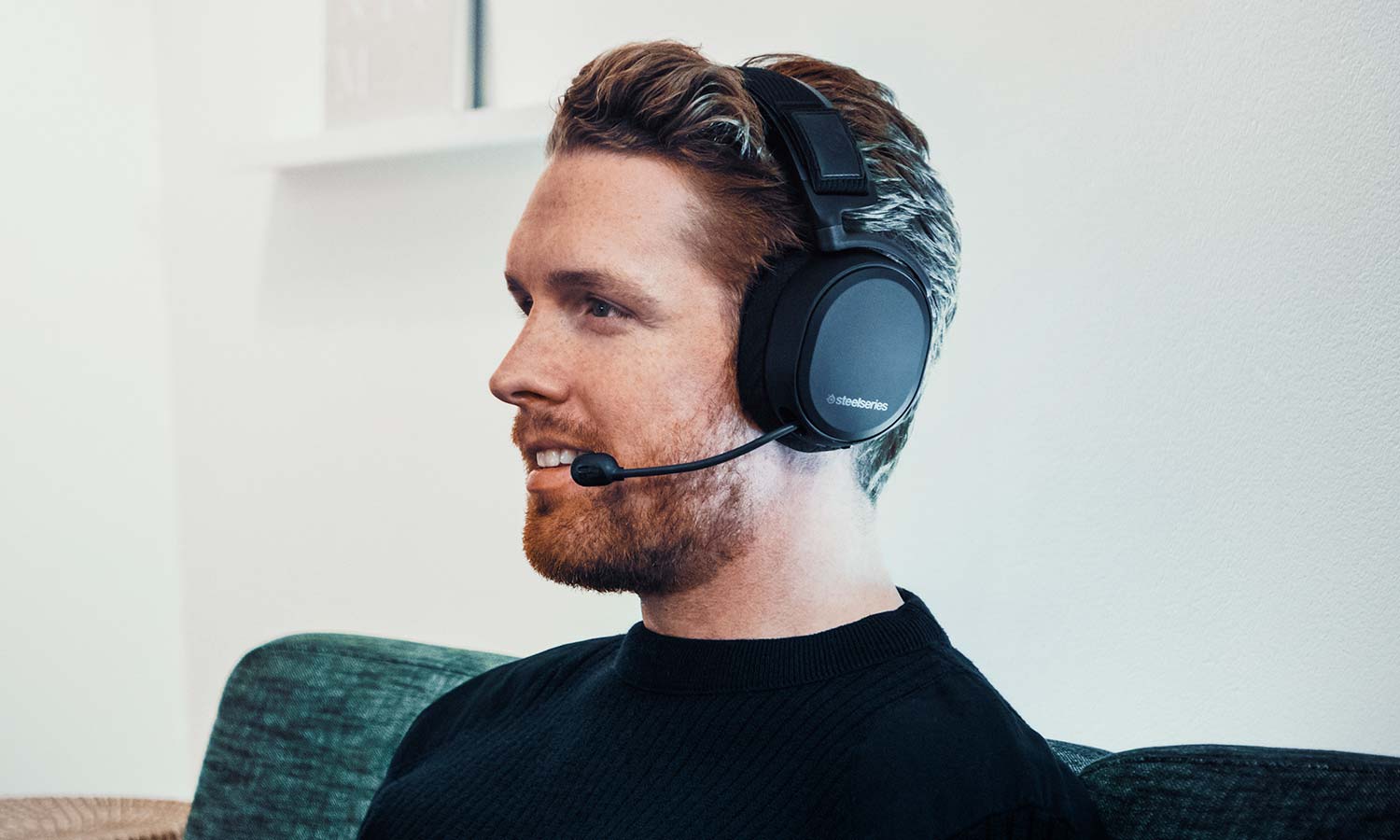Tom's Guide Verdict
The SteelSeries Arctis Pro Wireless delivers nuanced sound and a plethora of audio options, all without the need for cumbersome software.
Pros
- +
Great sound
- +
Comfortable fit
- +
Robust transmitter
- +
Versatile connectivity
Cons
- -
Expensive
- -
Tedious setup
Why you can trust Tom's Guide
The SteelSeries Siberia 800 was an interesting experiment. Would gamers want to fine-tune their audio options on the fly — even on consoles — if it meant setting up a large transmitter rather than a simple USB dongle? The Siberia 840 sweetened the deal with Bluetooth, but the question still remained, as did the $330 price tag.
Enter the SteelSeries Arctis Pro Wireless ($330), a Siberia 840 for the current gaming generation. Compatible with PS4 and PC, the Arctis Pro Wireless combines the Siberia 840's sophisticated receiver with the Arctis line's sleek design — with compelling results. The Arctis Pro Wireless delivers nuanced sound, a plethora of audio options and a crystal-clear mic, all without the need for cumbersome software.
However, at the end of the day, you're still dishing out more than $300 for a wireless gaming headset. And while the Arctis Pro Wireless delivers great sound, it's not a night-and-day difference from the $150, also-wireless Arctis 7.
While the Arctis Pro Wireless involves a complicated setup procedure and a lot of money up front, the final product impressed me overall. Whether you need such an expensive piece of gear ultimately depends on your gaming space and how many things you want to tweak.
Design
The SteelSeries Arctis line represents my favorite headset design of the past few years, and the Arctis Pro Wireless wisely doesn't do much to change things up.
The black plastic chassis is medium-sized, lightweight and just plain unassuming. With a matte finish and no sharp edges, the Arctis Pro Wireless is a joy to wear either at a gaming station or when you're out and about. Large, plush ear cups sit over the ears and don't press down too tightly.
My favorite physical feature on the headset is, as always, the elastic "ski goggles"-style headband, which helps you get a perfect fit without ever having to micromanage tedious notches. You can adjust the overall tightness with a Velcro strap, but you basically just put the headset on top of your dome and let gravity do the rest. It's a beautiful thing, and I'm grateful that other manufacturers are finally starting to come around to this design.
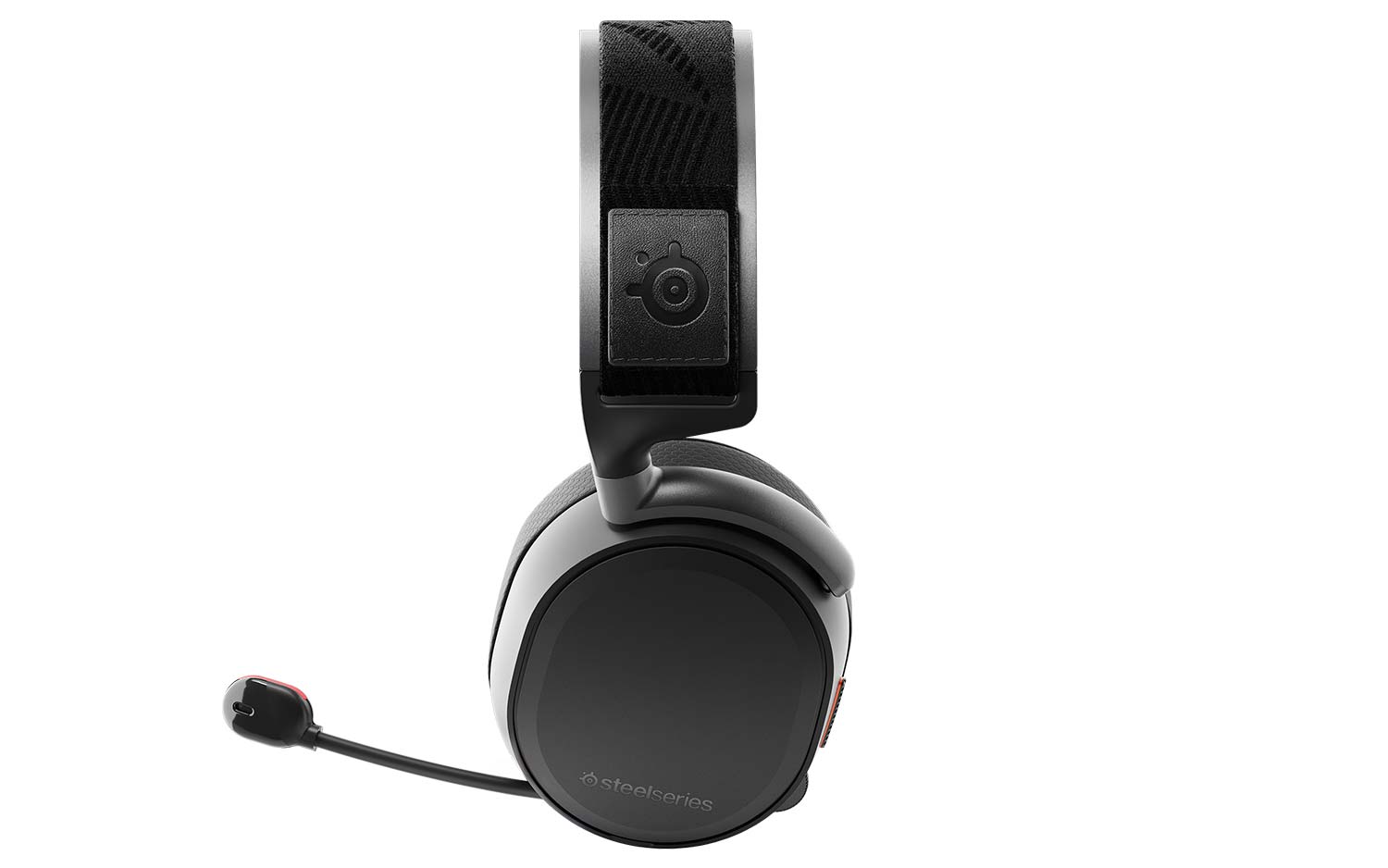
Otherwise, the Arctis Pro Wireless keeps things pretty simple. There's a retractable mic in front of the left ear cup, with a mic mute button and a volume wheel on the back of the ear cup. You'll also find a few different connectors for audio ports and charging cables. The right ear cup simply houses the battery, which you can hot-swap, thanks to a second battery that charges constantly inside the transmitter. (More on that later.)
Instead of connecting via USB dongle as most wireless headsets do, the Arctis Pro Wireless communicates through a large transmitter box (a 4-inch square with rounded edges), which you connect to either your PS4 or PC via USB. The box is very simple, with two buttons, a knob, and a black-and-white OLED display on the front, and a variety of audio and power ports in the back.
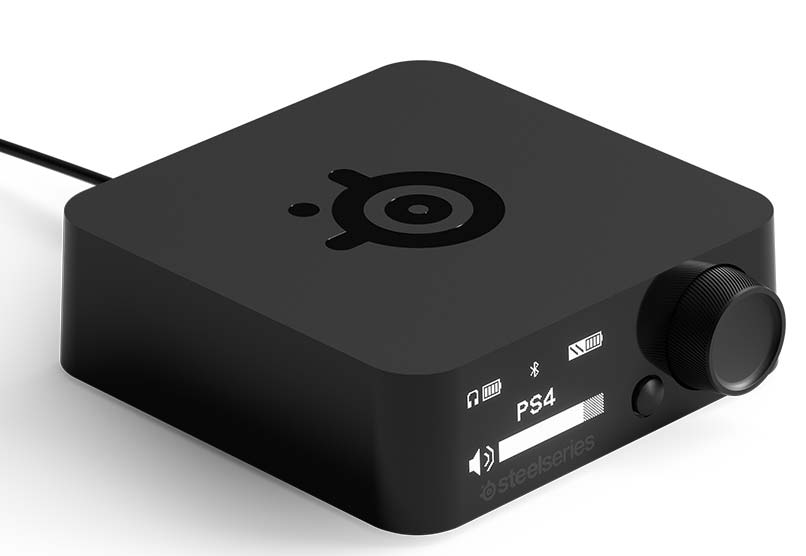
The box itself is fine, and thanks to an inspired design decision, you can control most of its features right from the headset, using the volume dial. My only complaints are that it's not crystal clear what every port does (most setups require only two or three of them), and that if you use a living-room setup, it's nearly impossible to see the tiny screen from couch distance.
With a matte finish and no sharp edges, the Arctis Pro Wireless is a joy to wear either at a gaming station or when you're out and about.
Granted, you could eventually learn all the options by rote memorization. But having to get up and walk over to the transmitter every time I wanted to do more than adjust the volume made the headset controls feel pretty superfluous.
Comfort
As stated above, the Arctis line represents some of the most comfortable headsets on the market. The Arctis Pro Wireless is no exception, since it's so easy to find your perfect fit. The device sat lightly on my head and made a tight — but not uncomfortably tight — seal around my ears. I wore it for hours of gameplay, commuting and just sitting around, listening to music with no ill effect.
I handed the headset off to a co-worker, who agreed with my assessment — and then proceeded to wear the headset for the rest of the day, not wanting to return it. SteelSeries is obviously doing something right.
Gaming Performance
Because the Arctis Pro Wireless has so many ports in its transmitter, you can connect it to your gaming device a variety of ways. To start, though, let's talk about the quality on PS4 and PC, since SteelSeries had those two systems in mind when it designed the headset.
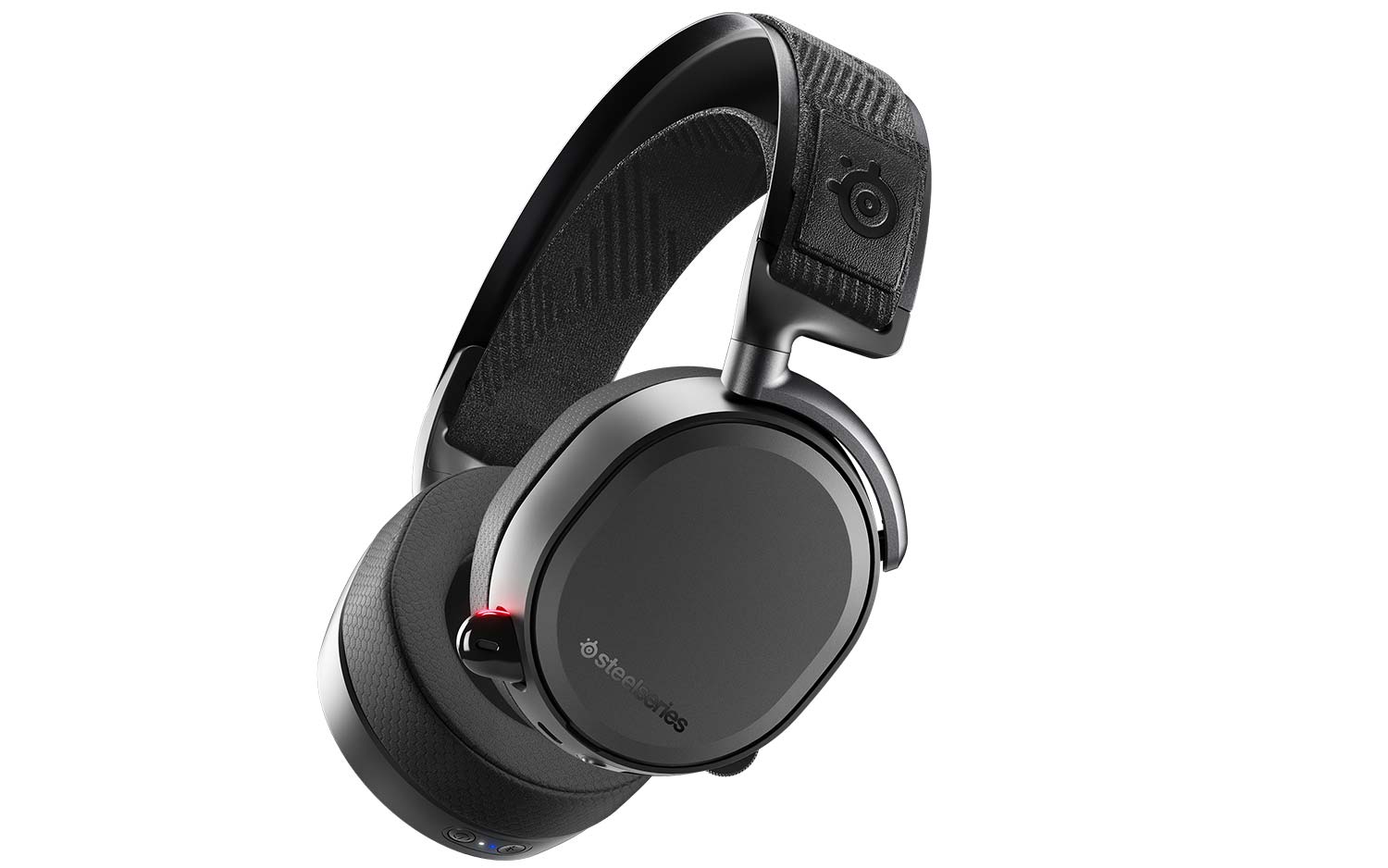
First off, while you'll connect the transmitter to PC via USB and to PS4 via optical audio cable, the sound quality is the same either way. It simply has to do with how each system processes linear PCM sound. Thanks to the transmitter, you can experience 7.1 surround sound on either platform, as well as adjust equalization options for Immersion (single-player games), Performance (multiplayer games), Music, Entertainment and more.
If you've used other Arctis headsets, you won't be surprised to learn that the Arctis Pro Wireless sounds great. While it's definitely worth tweaking the equalization options (I wasn't actually that impressed with the default Balanced setting, which sounded treble-heavy and muddled for most applications), you'll experience subtle highs, clear mids and defined lows. I wish the bass had a little more power behind it, especially for music, but the balance was generally just right for gaming.
I tested the headset with a variety of PC and PS4 games, including Middle-earth: Shadow of War, StarCraft: Remastered, Overwatch and .hack//G.U. Last Recode. Between Immersion and Performance modes, the Arctis Pro Wireless delivered everything I needed, whether it was tight directional sound for flying around the map as D.Va, or clear dialogue for the extensive and heartfelt voice work from Haseo and the quirky characters in his party.
PC gamers are probably used to headsets delivering this level of sound quality, but it's much rarer on the PS4. Hearing music, sound effects and voice work pumped in through the optical audio cable (even though it requires a tedious setup) had a noticeable effect on just how good everything sounded. Music was clearer and more immediate; voices had more depth to them. Audiophiles who want to get the most out of their PS4s — especially if it's also their go-to machine for TV and movies — may want to check out the Arctis Pro Wireless for its console applications alone.
Between Immersion and Performance modes, the Arctis Pro Wireless delivered everything I needed, whether it was tight directional sound for Overwatch or clear dialogue for role-playing games.
Less exciting, but still worthwhile, is the way the Arctis Pro Wireless handles Bluetooth and 3.5-mm-cable audio. You can connect to a phone (or a PC, if you're not overly concerned about sound quality) via Bluetooth, and I found the connection to be both reliable and functional. Games like Tales of the Rays sounded just fine, and it's probably all the performance you'll need on a subway or a plane.
I also tested the 3.5-mm connection with an Xbox One controller, which is the only way the headset works with an Xbox One. Again, it was functional — better than a cheap headset, but not as good as a dedicated, high-end Xbox One accessory. However, it was a little obnoxious that the onboard volume controls didn't work in this mode; I had to adjust the volume through the Xbox menu, which is not that intuitive in the middle of gameplay.
(Worth noting, too: the 3.5-mm audio mode does not require any additional power, so you can listen and recharge at the same time. This shouldn't be a problem because of the second battery, but it's good to have the option, just in case.)
Features
The transmitter box is where all of the Arctis Pro Wireless' interesting features live. Here, you can adjust the chat mix, change (or create) equalization profiles, toggle surround sound, manage sidetone, switch inputs, control volume and more.
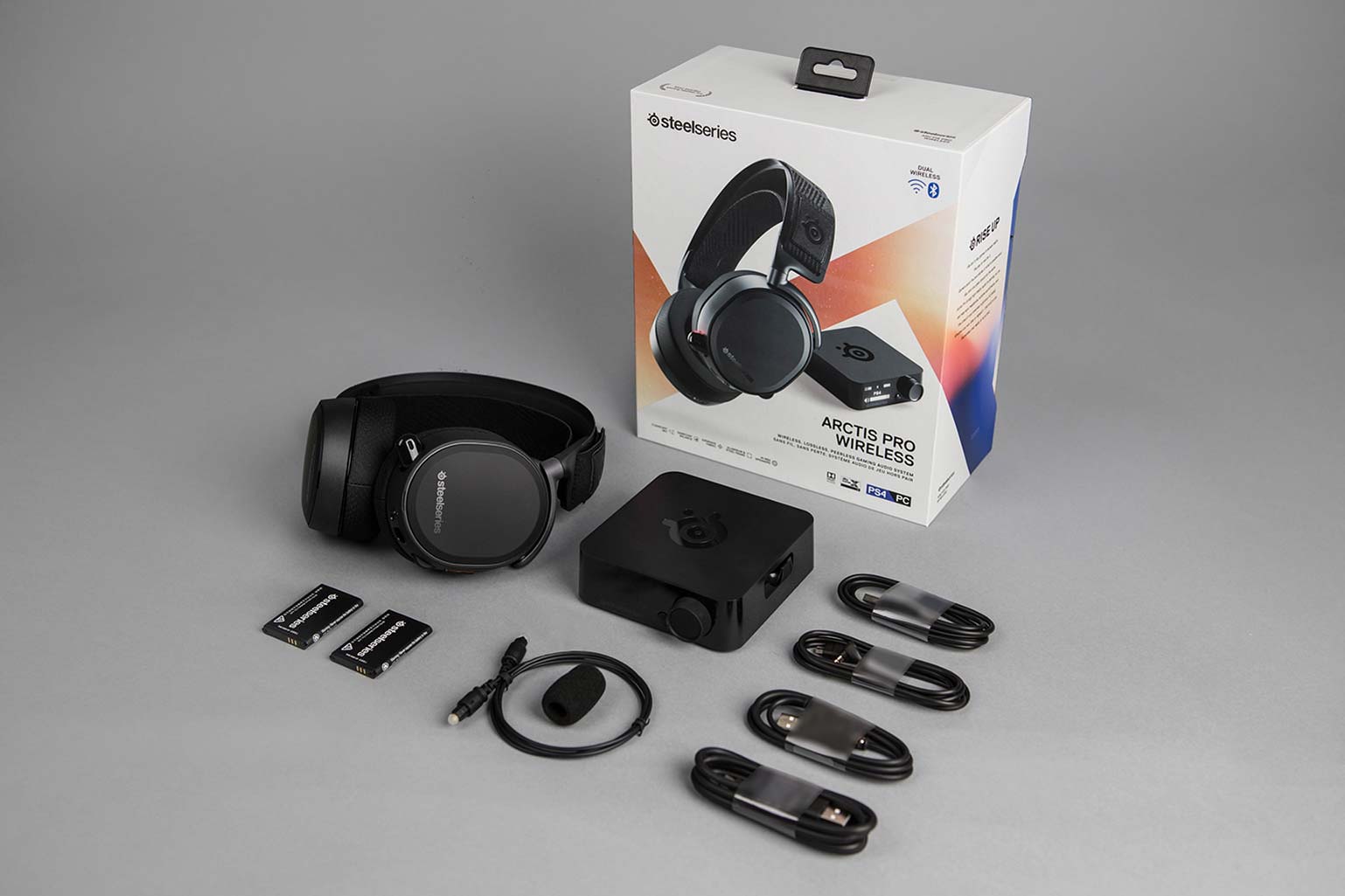
(The SteelSeries Engine software will eventually be able to offer all the same options on PC, but the proper update isn't available just yet. SteelSeries reps assured me that the transmitter can achieve all the same effects, so this shouldn't affect the review, unless something changes drastically.)
It's a pain that the OLED screen is so small, which makes it hard to see from far away. The box is also rather difficult to set up on both PS4 and PC (although, to be fair, you have to undergo this process only once). Apart from that, the transmitter box is a rather remarkable little device. The number of options you get is impressive, and their ability to be controlled via hardware rather than software — right from your headset, in most cases — makes it a lot more user-friendly than having to jump back and forth between a game and the Engine program.
The transmitter works so well, in fact, that its biggest flaw is that it can be in only one place at a time. Although SteelSeries optimized the Arctis Pro Wireless for both PC and PS4, the cumbersome setup and plethora of wires that go along with the transmitter make it a pain to transfer between the two systems, particularly if they're in different rooms. A SteelSeries rep explained that the "console at a desk" placement is more common than people might think, and, theoretically, you can have it hooked up to both a PS4 and a PC simultaneously. But if that's not the way your setup looks at home, you're going to have to choose which system you want it for, and set aside some time if you want to change it.
MORE: Best Gaming Headsets 2018
You don't have to switch back and forth between Bluetooth and a 2.4-GHz wireless connection on the Arctis Pro; you can have both active at the same time. This is useful if you want to, say, listen to a podcast on your phone while grinding levels on a PS4 game. But I can't help but shake the feeling that this was simply the easiest way to implement Bluetooth, rather than a design goal in and of itself.
Bluetooth comes with a few perks, at least. You can pause or skip songs right from the headset, as well as take calls or hang up on them. The microphone works just as well over Bluetooth as it does over 2.4 GHz.
Speaking of the microphone, it's up to usual Arctis standards: clear and precise, with just a little too much emphasis on P and S sounds. However, SteelSeries actually addressed my concern with a sensible (and economical) fix: a foam mic cover, which acts like a little pop filter. Sometimes, the simplest fixes really do work best.
Music Performance
I listened to tracks from Flogging Molly, Old Crow Medicine Show, The Rolling Stones, G.F. Handel and (while I'm not proud to admit it) King Harvest on the Arctis Pro Wireless, and everything sounded pretty good. Voices were sonorous, instruments were crisp and the balance between the two was workmanlike.
However, the headset just doesn't offer that much in the low range, unless you really pump up the bass. It made it difficult to hear the twanging bass in Old Crow Medicine Show's "Carry Me Back to Virginia" or the lowest parts of the choir in Handel's "Messiah."
Here's the issue: The Arctis Pro Wireless sounds very similar to the Arctis 7 when it comes to music. That's fine, except that the Arctis 7 costs $150, whereas the Arctis Pro Wireless costs $330. For more than twice the price, I expected to hear a substantial difference in quality, but most of the price hike seems to have gone into the transmitter.
MORE: Best Headphones 2018
Perhaps this is a personal preference, but I feel that after a certain price threshold (let's say $150), your gaming headset should also double as an everyday music headset. The Arctis Pro Wireless can do that, but if you spent $330 on a dedicated music headset, you'd be able to afford some of the best consumer models on the market. Heck, even if you spent $150 on the Arctis 7 and another $170 on a pair of headphones from Sennheiser or Bose, you'd still be able to get something pretty impressive.
Battery Life
SteelSeries claims that the Arctis Pro Wireless can last up to 10 hours on a charge, which is in line with my own experience. Since the transmitter will always charge a second battery, you can, theoretically, swap between the two indefinitely. There's also an option to charge via micro USB, so it's hard to imagine a situation in which you'd be completely out of juice. You can also listen via 3.5-mm audio jack, regardless of whether the device has any power.
Arctis Pro Wireless vs. Arctis Pro + GameDAC
Alongside the Arctis Pro Wireless, SteelSeries is releasing a wired model: the $250 Arctis Pro + GameDAC.
Essentially, the Arctis Pro + GameDAC is an Arctis headset that comes with a specialized SteelSeries digital-to-analog converter. In theory, this allows the Arctis Pro + GameDAC to deliver higher-quality sound than its wireless counterpart. In fact, the headset has earned a coveted Hi-Res Audio certification — rare in a gaming peripheral. Hard-core audiophiles may want to look into the Arctis Pro + GameDAC, especially if a wireless setup is not necessary for them.
Bottom Line
If you want a rich audio experience with hardware-based equalization — especially on a PS4 — the Arctis Pro Wireless delivers in a big way. It's robust, it's intuitive and it's versatile. Unless you're a truly gifted music aficionado, you could conceivably use the Arctis Pro Wireless for every audio application in your life, from gaming at home, to listening to music on the train, to corresponding with co-workers on video calls. Every piece of the product feels premium, and if SteelSeries cut a corner anywhere during design or production, I can't find it.
However, the Arctis Pro Wireless does carry a few niggling annoyances with it. It's hard to connect to both a PC and a PS4; it's difficult to see the transmitter in a living-room setup; it's not as musically capable as it should be. There's also the matter of price. Three-hundred and thirty dollars is simply a tremendous amount of money to ask for a headset that, in terms of raw quality, is not worlds apart from the $150 Arctis 7.
While I think the Arctis 7 is still a fine wireless choice for most gamers, those with some extra money to burn should definitely check out the Arctis Pro Wireless. It doesn't come cheap, but the best things in life rarely do.
Credit: SteelSeries
Marshall Honorof is a senior editor for Tom's Guide, overseeing the site's coverage of gaming hardware and software. He comes from a science writing background, having studied paleomammalogy, biological anthropology, and the history of science and technology. After hours, you can find him practicing taekwondo or doing deep dives on classic sci-fi.
-
n.t.grimm Wasn't clear from the review/product announcement. Is it possible to adjust chat/game mix from the headset via dial/buttons (even if tedious), or are you required to adjust those features from the transmitter box?Reply -
thecontract4u u can easily adjust it from the headset directly and also most other features with the volume wheel press once and steering to select menues and press again for chose the optionsReply -
Travis Trinh You didn't discuss chat functions for the PS4 in your review. Would you need to connect both the USB and optical cable to your PS4 to chat? Alternatively, would you be able to use the optical cable and 3.5mm port on the headset connected to your controller to chat? Can the 3.5mm port on the headset even be used to chat, or is it input only with no output?Reply
